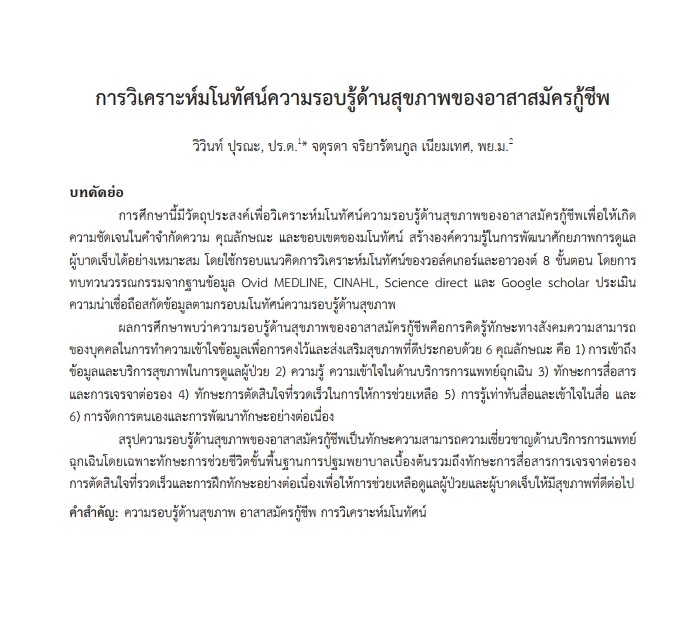การวิเคราะห์มโนทัศน์ความรอบรู้ด้านสุขภาพของอาสาสมัครกู้ชีพ
คำสำคัญ:
ความรอบรู้ด้านสุขภาพ, อาสาสมัครกู้ชีพ, การวิเคราะห์มโนทัศน์บทคัดย่อ
การศึกษานี้มีวัตถุประสงค์เพื่อวิเคราะห์มโนทัศน์ความรอบรู้ด้านสุขภาพของอาสาสมัครกู้ชีพเพื่อให้เกิดความชัดเจนในคำจำกัดความ คุณลักษณะ และขอบเขตของมโนทัศน์ สร้างองค์ความรู้ในการพัฒนาศักยภาพการดูแลผู้บาดเจ็บได้อย่างเหมาะสม โดยใช้กรอบแนวคิดการวิเคราะห์มโนทัศน์ของวอล์คเกอร์และอาวองต์ 8 ขั้นตอน โดยการทบทวนวรรณกรรมจากฐานข้อมูล Ovid MEDLINE, CINAHL, Science direct และ Google scholar ประเมินความน่าเชื่อถือสกัดข้อมูลตามกรอบมโนทัศน์ความรอบรู้ด้านสุขภาพ
ผลการศึกษาพบว่าความรอบรู้ด้านสุขภาพของอาสาสมัครกู้ชีพคือการคิดรู้ทักษะทางสังคมความสามารถของบุคคลในการทำความเข้าใจข้อมูลเพื่อการคงไว้และส่งเสริมสุขภาพที่ดีประกอบด้วย 6คุณลักษณะ คือ 1) การเข้าถึงข้อมูลและบริการสุขภาพในการดูแลผู้ป่วย 2) ความรู้ ความเข้าใจในด้านบริการการแพทย์ฉุกเฉิน 3) ทักษะการสื่อสารและการเจรจาต่อรอง 4) ทักษะการตัดสินใจที่รวดเร็วในการให้การช่วยเหลือ 5) การรู้เท่าทันสื่อและเข้าใจในสื่อ และ 6) การจัดการตนเองและการพัฒนาทักษะอย่างต่อเนื่อง
สรุปความรอบรู้ด้านสุขภาพของอาสาสมัครกู้ชีพเป็นทักษะความสามารถความเชี่ยวชาญด้านบริการการแพทย์ฉุกเฉินโดยเฉพาะทักษะการช่วยชีวิตขั้นพื้นฐานการปฐมพยาบาลเบื้องต้นรวมถึงทักษะการสื่อสารการเจรจาต่อรอง การตัดสินใจที่รวดเร็วและการฝึกทักษะอย่างต่อเนื่องเพื่อให้การช่วยเหลือดูแลผู้ป่วยและผู้บาดเจ็บให้มีสุขภาพที่ดีต่อไป
เอกสารอ้างอิง
Ad Hoc Committee on Health Literacy for the Council on Scientific Affairs.(1999). Health literacy: report of the council on scientific affairs. J Am Med Assoc, 281(6), 552-557.
Australian Bureau of Statistics. (2008). Adult literacy and life skills survey. Summary results Australia, Canberra: Australian Bureau of Statistics. Retrieve from https://www.voced.edu.au/content/ngv%3A41226.
Chumnanborirak, P., & Srikaew, S. (2015). Development of knowledge and skills of emergency medical services among volunteer rescuers at Wungsang subdistrict administration organization, Mahasarakham province. Nursing Journal of the Ministry of Public Health, 24(3), 132-142.
Institute of Medicine. (2004). Health literacy: A prescription to end confusion. Washington DC: The National Academies.
Kaewdumkerng, K., & Thamakul, D. (2015). Enhancement of health literacy in the elderly population. Journal of Health Scientific Research, 9(2), 1-8.
Kaewdumkerng, K., & Tripetchsriurai, N. (2011). Bangkok: Sam Charoen Panich. [In Thai].
Khawelamoon, B. (2017). Effects of the emergency medical networking program on knowledge and skills of emergency medicine in community emergency volunteers at Pha-hung subdistrict, Phan district, ChiangRai province. Master's Independent Study, Public Health, University of Phayao.
Kickbusch, I. S. (2001). Health literacy: Addressing the health and education divide. Health Promot Intern, 16(3). 289–297.
Lueangvilai, W., Kanchanakunjara, S., & Wongpinpech, P. (2020). Volunteer spirit development in the context of Thailand. Panyapiwat Journal; 13(1), 336-350.
National Institute of Emergency Medicine. (2008). Standards and guidelines on emergency medical systems (edition No. 1). Nonthaburi: National Institute of Emergency Medicine. [In Thai].
Nutbeam, D. (2000). Health literacy as a public health goal: A challenge for contemporary health education and communication strategies into the 21st century. Health Promotion International; 15, 259–267.
Ratzan, S. C. (2001). Health literacy: Communication for the public good Health Promot Intern, 16(2), 207-214.
Saranritchai, K., (2003). Community perceptions of emergency patient services at the scene. Veridian E-Journal, 7(1), 184-190.
Seelatho, T. (2015). Potential of Khon Kaen province volunteer rescue workers, Nai Mueang, Mueang, Khon Kaen. Journal of Interdisciplinary Research: Graduate Studies, 4(2), 102-107.
Thammikaworn, S. (2008). Health awareness for health promotion: A conceptual analysis. Journal of the Faculty of Nursing Khon Kaen University, 31(2), 53-58.
Truppanaray, N. (2016). actor effecting pre-hospital emergency operations among emergency medical responders of Rachaburi province. Master's Thesis, Community Psychology Department of Psychology and Guidance, Graduate School, Silpakorn University.
Tones, K. (2002). Health literacy: New wine in old bottles? Health Educ Res, 17(3), 287-290.
Toyokuni, Y., Suzukawa, M., Yamashita, K., Yonekawa, C., Kubota, K., Yasuda, Y., Kobayashi, A., & Matsubara, H. (2013). Introduction of the community first responder system into Japan: Is that possible? International Journal of Emergency Medicine, 6(34), 1-7.
Walker, L., & Avant, K. (2011). Strategies for theory construction in nursing (5th ed.). New Jersey: Pearson prentice hall.
World Health Organization. (2009). Concepts and examples in the eastern mediterranean region.Nairobi.

ดาวน์โหลด
เผยแพร่แล้ว
รูปแบบการอ้างอิง
ฉบับ
ประเภทบทความ
สัญญาอนุญาต

อนุญาตภายใต้เงื่อนไข Creative Commons Attribution-NonCommercial-NoDerivatives 4.0 International License.




